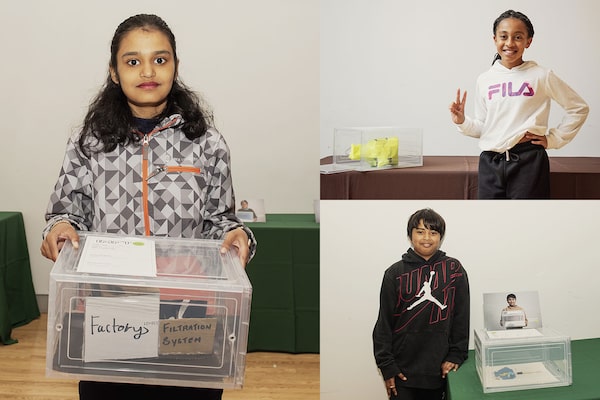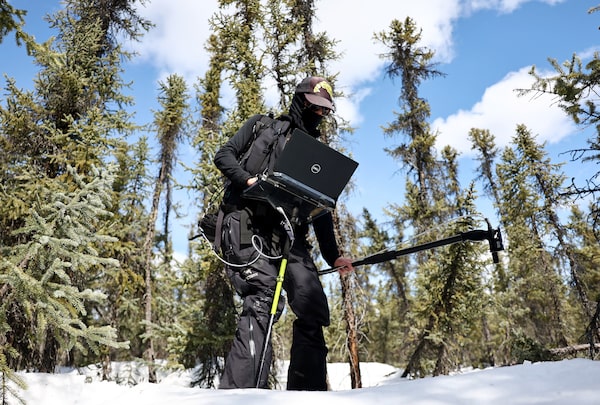If you’re reading this on the web or someone forwarded this e-mail newsletter to you, you can sign up for Globe Climate and all Globe newsletters here.
Good afternoon, and welcome to Globe Climate, a newsletter about climate change, environment and resources in Canada.
It’s award season in the journalism world, and just this weekend The Globe and Mail lead the National Newspaper Awards, receiving nine NNAs and 19 nominations honouring our work. One you will remember from Globe Climate was written by Kathryn Blaze Baum, who has also won multiple NNAs. This year she was awarded for her explanatory work laying out the devastating effects of rising temperatures on the human body.
The Globe was also nominated for 24 Digital Publishing Awards. Many stories that have appeared in this newsletter are on the list, including about damage to B.C.’s Highway 8 and rebuilding efforts on the Coquihalla highway after heavy rain and extensive flooding in 2021, our piece on Ontario’s abandoned gas wells, and fighting climate change up North using Inuit knowledge with scientific expertise.
Congrats to all the winners this year! Now, let’s catch you up on other news.
Noteworthy reporting this week:
- B.C. Flooding: Hundreds of residents in B.C.’s Interior on evacuation alert as more rain threatens new flooding and mudslides after spring thaw. Protection still a patchwork, despite promises of change.
- Alberta Wildfires: Alberta has declared a state of emergency due to the threat of wildfires as more than 100 active fires have been forcing thousands to evacuate their homes
- Energy: Ottawa’s clean-electricity strategy faces opposition from Prairie provinces
- Development: Port of Vancouver sees expansion as crucial even as global shipping slumps, environmental opposition
- Mining: There’s a small resurgence in Canadian coal mining, but compensation boards are ill-prepared for the harm to workers’ lungs
- Oceans: Sustainable Marine Energy bins Canadian operations, accuses federal department of blocking green project
- Agriculture: Nova Scotia grape growers facing catastrophic loss after volatile winter weather
- Listen to The Decibel: Doug Saunders, international columnist at The Globe, on what we’re getting wrong about climate refugees
- Opinion: As our cities grow warmer, it’s time to rethink what and where nature is. And make neighbourhoods better equipped for the coming climate crisis
- Changing landscapes: PEI tourism operators racing to get ready for coming season after Hurricane Fiona’s devastation
- From The Narwhal: Clearcuts, forestry roads and threats to biodiversity abundant in Manitoba’s only logged park
A deeper dive
The Arctic Circle is an unlikely place to grow bell peppers and strawberries
Amber Bracken is a freelance photojournalist. For this week’s deeper dive, she talks about a story she wrote while visiting and learning with a community in Gjoa Haven.
In the comfort of lives on the grid, our interdependence is masked, but a sharp-toothed, quick biting Arctic wind cuts through all illusions to the soft heart of human vulnerability. Even as an Edmontonian, facing such a frozen expanse is humbling.
My visit to Gjoa Haven, NT in the dead of winter had me marvelling at the incredible accomplishment of Inuit who have transformed the incomprehensibly inhospitable landscape into a home. For five millennia people have relied on one another to survive and thrive in an extreme climate.
I was there to visit Naurvik, “the growing place” in Inuktitut, a hydroponic greenhouse producing fresh local vegetables against all odds. Hunkered in insulated sea cans and powered primarily with renewable energy, the project is a collaboration between the community and Arctic Research Foundation, Agriculture and Agri-Food Canada, National Research Council Canada and Canadian Space Agency.
Greenhouse manager Betty Kogvik at the Naurvik greenhouse project, "the growing place" in Inuktitut, in Gjoa Haven, NT.Amber Bracken/The Globe and Mail
Food has never come easy in the North. Before colonization, generations of Inuit were nomadic hunters, trekking seasonally to follow whales, seals, fish, caribou, muskox, geese and berries. With Europeans came Residential Schools, forced relocations and, starting in the 1950s, the Canadian government engineered permanent settlements with the intent to better offer health and education services—but all disrupted the ancient system.
Today, food insecurity is endemic in Nunavut affecting more than half of all households, according to 2017-2018 Stats Canada data. People still rely on traditional “country food”, typically shared with family and friends, but fuel and supplies for hunting are expensive and climate change promises further complications for hunters. So most people also shop for their food. Long transport distances from the south increase grocery prices—during my visit in February four litres of milk cost $12.49—and the quality of fresh food often suffers.
That’s why local food production such as the Naurvik greenhouse is part of the Nunavut Food Security coalition’s action plan and why elders in Gjoa Haven are asking for more production. Powered primarily by wind and solar, with a diesel generator for emergencies, the project also promises economic and environmental sustainability.
I knew all this, intellectually, but the magic of finding strawberries, steps from an arctic fox was still a revelation in person. The feel of warm, moist air on my frost-nipped face and the gorgeous smell of plants breathing, lovingly tended by Inuit in the unlikely space demonstrated a possibility. Many things have changed in the Arctic, but food, community and climate will always be intertwined.
- Amber
The Arctic Research Foundation's greenhouse project is shaped by the extreme northern environment more comparable to growing in space than in most other places on earth, in Gjoa Haven, NT.Amber Bracken/The Globe and Mail
What else you missed
- Vancouver’s new emissions bylaw creates value for buildings
- As Quebec cities recover from flooding, Legault warns not enough money to go around
- India and China propose multiple pathways on cutting use of fossil fuels, sources say
- TotalEnergies sues Greenpeace over emissions report
- Spanish coal mine operator gets four-year prison sentence for environmental damage
- Berkeley professor of environmental science, policy and management apologizes for falsely identifying as Indigenous
- Maine authorities hit Canadian Pacific Kansas City with violation notice from its cleanup efforts after derailment in April
- 258 million people faced acute food insecurity in 2022, says UN
Opinion and analysis
Amy Lofting: I’ve seen the slow transformation of cycling in Calgary
Tony Keller: An oil and gas superpower that’s also an environmental leader. Why can’t Canada be Norway?
Sandford Borins: The proposed Therme spa could be Highway 407 all over again
Green Investing
For a crash course in RI, ask your advisor these four questions
Nearly three in four Canadians want more information about responsible investing (RI), or investing with environmental, social and governance (ESG) performance in mind, according to a survey from the Responsible Investment Association. Yet only about three in 10 said their financial adviser had broached the subject, and 70 per cent said they knew little RI.
It’s important to ask your adviser questions to better understand RI strategies and options, the risks involved and your adviser’s specific approach to this type of investing. We’ve got four questions you can use to start.
- DeSantis signs sweeping anti-ESG legislation in Florida
- ISS advises Shell shareholders to vote against climate activist resolution seeking faster emissions cuts
- Employment: Canada’s Greenest Employers 2023 embrace sustainability on all fronts
- Rosenberg: 12 top stock picks for taking advantage of an opportune time to invest in Canadian clean tech
Making waves
Each week The Globe will profile a Canadian making a difference. This week we’re highlighting the work of young people in the It’s My Future Toronto program set out to design a better world.

Imani Canterbury, 11, and Karmanvir Bharath, 11, were three of the Torontonians who took part in this year’s It’s My Future Toronto program for BIPOC youth.Duane Cole/The Globe and Mail
Children can design solutions for a better world. That’s the thinking behind It’s My Future Toronto, a program created by OCAD University’s dean of design, Dori Tunstall. Launched in 2021, IMFTO guided a group of 17 BIPOC students through the critical thinking, design and presentation skills needed to identify problems in their communities and pitch solutions.
We’ve got a sample of some of the students’ work which ranges from a filtration system for harmful exhaust, a tax policy to reduce carbon-dioxide emissions, and even a solar-powered tree planter.
Do you know an engaged individual? Someone who represents the real engines pursuing change in the country? Email us at GlobeClimate@globeandmail.com to tell us about them.
Photo of the week

NASA SnowEx campaign member Dr. Kelly Gleason works on skis while taking measurements of snow albedo (reflectivity) in a section of boreal forest during the melt season on May 4, 2023 near Fairbanks, Alaska. NASA's multi-year airborne and field SnowEx campaign is testing remote sensing technologies in diverse snowpack environments to prepare NASA for future satellite missions which will monitor the amount of water held in snowpacks worldwide amid a changing climate.Mario Tama/Getty Images
Guides and Explainers
- Want to learn to invest sustainably? We have a class for that: Green Investing 101 newsletter course for the climate-conscious investor. Not sure you need help? Take our quiz to challenge your knowledge.
- We’ve rounded up our reporters’ content to help you learn about what a carbon tax is and just generally how Canada will change because of climate change.
- We have ways to make your travelling more sustainable and if you like to read, here are books to help the environmentalist in you grow, as well as a downloadable e-book of Micro Skills - Little Steps to Big Change.
Catch up on Globe Climate
- Ottawa and Ontario don’t share the same vision for electricity’s future
- Environmental education with a cosmic twist
- How Vietnam challenges what ‘climate refugees’ look like
- We went to Peruvian oil country to see the lack of Canadian corporate oversight
We want to hear from you. E-mail us: GlobeClimate@globeandmail.com. Do you know someone who needs this newsletter? Send them to our Newsletters page.